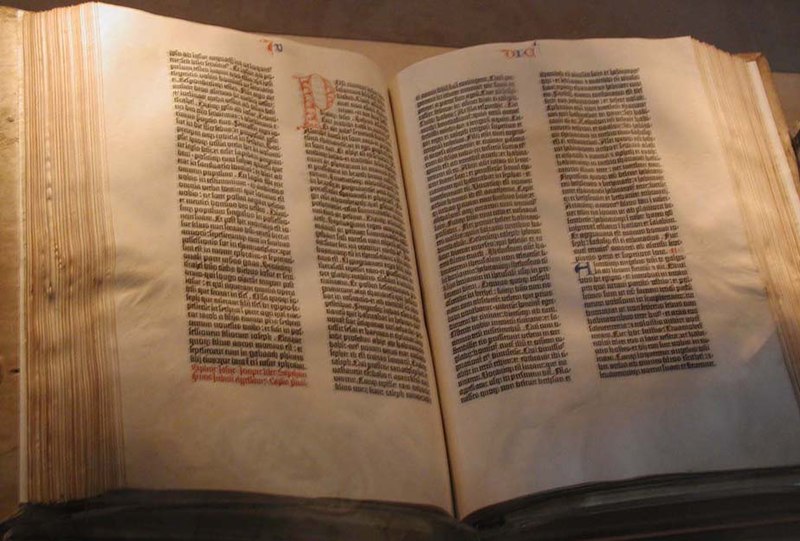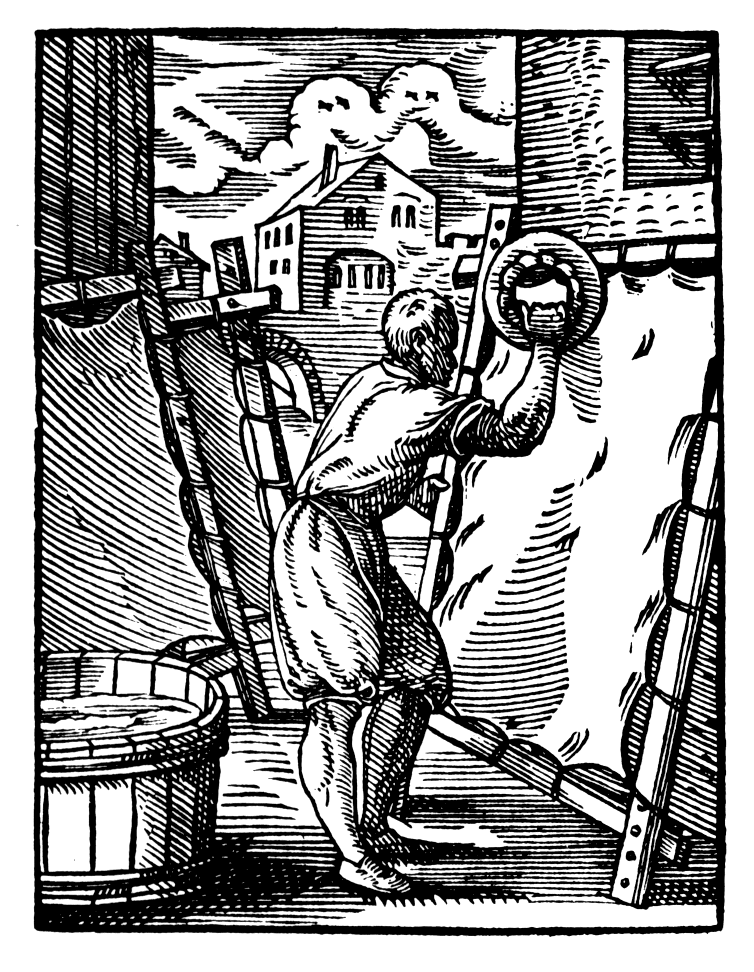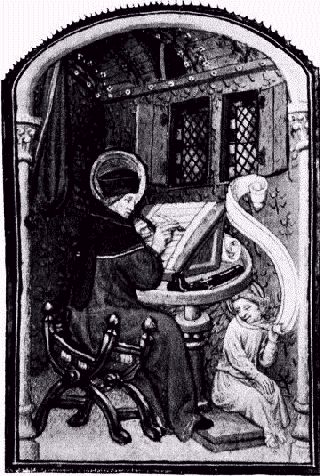 CHARLEMAGNE was King of the Franks and leading ruler of central Europe and the Roman Empire. He introduced the feudal system to bring order to chaotic society. He fostered a revival of learning and the arts and recruited Alcuin of York to establish a school. Also, he mandated reform in the poor writing and illustrations.
CHARLEMAGNE was King of the Franks and leading ruler of central Europe and the Roman Empire. He introduced the feudal system to bring order to chaotic society. He fostered a revival of learning and the arts and recruited Alcuin of York to establish a school. Also, he mandated reform in the poor writing and illustrations.CADMUS OF MILETUS allegedly may have brought the alphabet to Greece. Mythology reports Cadmus, King of Phoenicia went to find his sister Europa whom was kidnapped by Zeus. He killed a dragon and planted his teeth which an army then grew from.
 GUTENBERG was a German goldsmith and printer credited with inventing movable type printing in Europe and mechanical printing globally. He is known for the Gutenberg bible also known as the 42-line bible.
GUTENBERG was a German goldsmith and printer credited with inventing movable type printing in Europe and mechanical printing globally. He is known for the Gutenberg bible also known as the 42-line bible.ALPHABET is a standardized set of letters, each representing a phoneme of spoken language derived from alpha and beta the first two letters of the Greek alphabet.
ARAMAIC is a group of Semitic languages with a 3000 year history. It was the language of administration and empires and the language of divine worship.
BLACKLETTER is known as Gothic script or Gothic minuscule, and was used throughout Europe from 1150 to 1500. It was developed from the Carolingian minuscule

BOOK OF HOURS is the most common type of surviving medieval illuminated manuscript containing collection of texts, prayers, psalms and illustrations to form reference for Catholic Christian worship and devotion.
BOUSTROPHEDON is an ancient way of writing manuscripts and other inscriptions. Rather than left to right or right to left, alternate lines read in opposite directions.

CAROLINGIAN MINUSCULE is a script developed as a writing standard in Europe so that the Roman alphabet could be easily recognized by the small illiterate class from one region to another.
CARPET PAGE is an early medieval form of illuminated manuscript ornamentation that comes at the beginning of each of the four Gospels in the New Testament.
CODEX is a book in the format used for modern books, with separate pages normally bound together and given a cover, replacing the scroll.
ILLUMINATED MANUSCRIPT is a manuscript in which the text is supplemented by decoration, such as initials, borders and miniature illustrations.
 "In the strictest definition of illuminated manuscript, only manuscripts decorated with gold or silver, like this miniature of Christ in Majesty from the Aberdeen Bestiary (folio 4v), would be considered illuminated." - Taken from Wikipedia.org
"In the strictest definition of illuminated manuscript, only manuscripts decorated with gold or silver, like this miniature of Christ in Majesty from the Aberdeen Bestiary (folio 4v), would be considered illuminated." - Taken from Wikipedia.org KORAN is a holy book, also called Quran or Al-Qur'an, and is the central religious text of Islam today, believed to be the literal word of God. It is possibly one of the first texts written in Arabic, and was originally transmitted by calligraphers. Though most Muslims today use printed editions, respect for the book and its writings has elevated the art of calligraphy in Muslim culture.
KORAN is a holy book, also called Quran or Al-Qur'an, and is the central religious text of Islam today, believed to be the literal word of God. It is possibly one of the first texts written in Arabic, and was originally transmitted by calligraphers. Though most Muslims today use printed editions, respect for the book and its writings has elevated the art of calligraphy in Muslim culture. LACERTINES are interlacing designs created with animal forms on Celtic carpet pages in the late seventh century. The animal forms were a figment of the illustrator's imagination, not realistic renderings.
 PARCHMENT is a writing surface made from the skins of animals. The skin would have been first washed and all hair or wool removed, then stretched tightly on a frame, scraped to remove all traces of hair and flesh, and then whitened with chalk and smoothed with a pumice. Vellum is a fine parchment made from the smooth skins of newborn calves. Parchment came into common use around 190 B.C., and was used in codices, the first books. This was a revolutionary design format in its day of fragile and awkward papyrus scrolls.
PARCHMENT is a writing surface made from the skins of animals. The skin would have been first washed and all hair or wool removed, then stretched tightly on a frame, scraped to remove all traces of hair and flesh, and then whitened with chalk and smoothed with a pumice. Vellum is a fine parchment made from the smooth skins of newborn calves. Parchment came into common use around 190 B.C., and was used in codices, the first books. This was a revolutionary design format in its day of fragile and awkward papyrus scrolls. SCRIPTORIUM was the room in medieval monasteries devoted to the hand-copying of manuscripts by monastic scribes. They were usually located adjacent to the library. The monastic libraries and scriptoria held a great amount of power in the 6th century as they were the primary source of reading material, thus defining literary culture and selectively preserving Western history.
 "Paul Pierce within an illustration of a Mediæval Scriptorium. From a manuscript of a Book of Prayers. 15th Century. British Museum, Slo. 2468." - Taken from Wikipedia.org
"Paul Pierce within an illustration of a Mediæval Scriptorium. From a manuscript of a Book of Prayers. 15th Century. British Museum, Slo. 2468." - Taken from Wikipedia.orgUNCIAL is a rounded writing style developed by the Greeks and commonly used from the 3rd to 8th centuries by Latin and Greek scribes. They were created to speed up the process of writing as their round forms required fewer strokes than square capitals and rustic capitals. From the 8th century to the 13th century, it was more often used for headings and titles, particularly in Illuminated Manuscripts. Uncials eventually developed into half-uncials, which is similar to modern upper and lower case.

C. 1700 B.C. The Phaistos Disk, which dates back to Minoan civilization, is a flat terra-cotta disk, six inches in diameter, covered in alphabetic forms. Its figures have been stamped into the clay rather than scribed, thus we have the first appearance of moveable type in history.
C. 1500 B.C. By this time, the Phoenicians had developed their own alphabet, a totally abstract system of 22 characters. Most of these early writings were on parchment and have unfortunately perished. The Phoenician alphabet was later adapted and revised by the Greeks and Romans.
C. 1000 B.C. Around this time, the Greeks adopted the Phoenician alphabet. There are many wonderful myths surrounding the details of exactly how the Phoenician alphabet made it to Greece; what is certain is that the Greeks changed five consonants to vowels and applied geometric structure and order to the uneven Phoenician characters. Athens officially adopted a standardized version in 400 B.C.